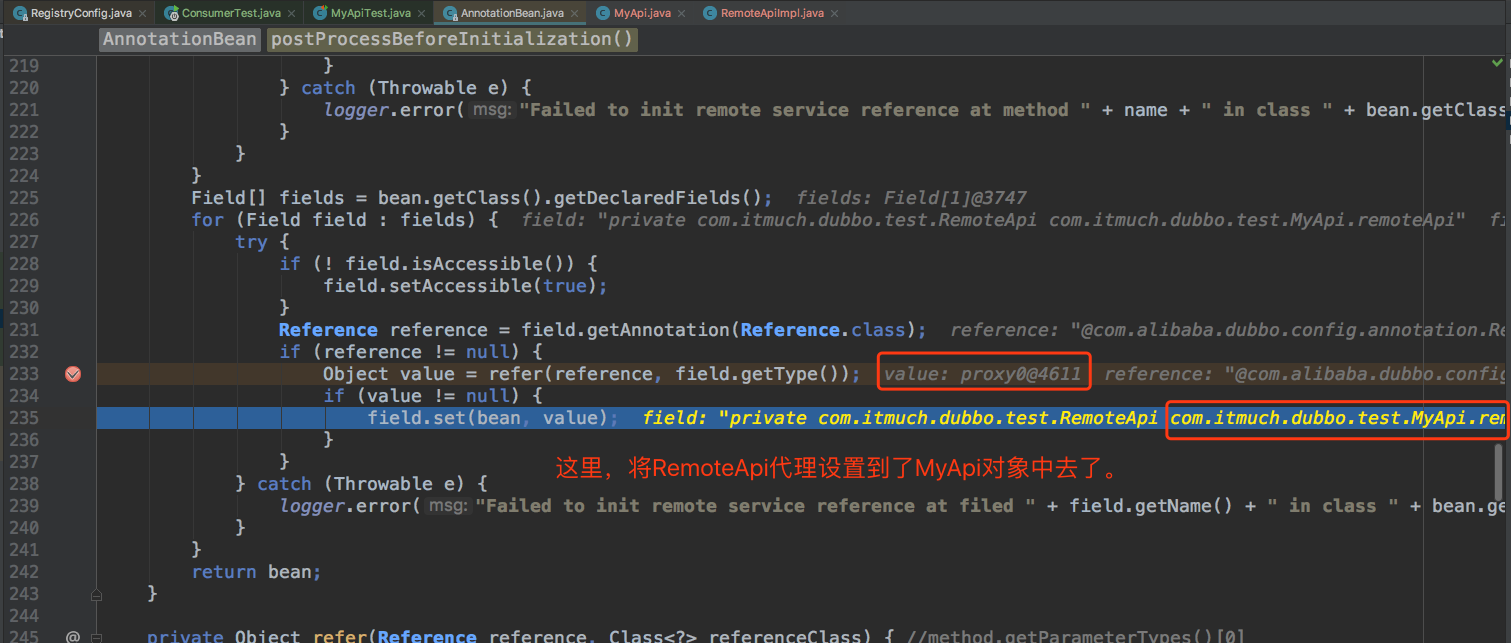Spring Boot、Dubbo项目Mock测试踩坑与总结
本文是对Spring Boot、Dubbo项目进行Mock测试的总结与踩坑实录。
搜索了一圈,居然没发现类似的文章,莫非用Dubbo的朋友们都不Mock测试,或者有其他的办法测试吗?
简单总结了一下,希望对大家能有一定参考意义。如果有更好的测试方法,请联系我的邮箱eacdy0000@126.com ,帮忙告知一下。
背景
手上有个整合了Dubbo的Spring Boot应用,在应用中需要消费其他服务的API。由于我依赖的服务并不由我所在的项目组维护(对方可能接口中途会发生变化,甚至,有时候可能并未启动)。
集成测试成本略高,故而想办法Mock测试。以RemoteApi为例,这是一个远程的API。我这一侧(消费者)的代码如下:
1 |
|
由代码可知,MyApi调用了一个远程的API RemoteApi。
下面我们来mock测试。
整合powermock
经过调研,笔者选择powermock作为项目的mock工具。
加依赖:
1
2
3
4
5
6
7
8
9
10
11
12
13
14
15
16
17
18
19
20
21
22
23<dependency>
<groupId>org.powermock</groupId>
<artifactId>powermock-module-junit4</artifactId>
<version>1.6.6</version>
</dependency>
<dependency>
<groupId>org.powermock</groupId>
<artifactId>powermock-api-mockito</artifactId>
<version>1.6.6</version>
<scope>test</scope>
</dependency>
<dependency>
<groupId>org.powermock</groupId>
<artifactId>powermock-module-junit4-rule</artifactId>
<version>1.6.6</version>
<scope>test</scope>
</dependency>
<dependency>
<groupId>org.powermock</groupId>
<artifactId>powermock-classloading-xstream</artifactId>
<version>1.6.6</version>
<scope>test</scope>
</dependency>测试启动类:
1
2
3
4
5
6
7
8
9
10
11
12
13
14
public class ConsumerTest {
public static void main(String[] args) {
SpringApplication.run(ConsumerTest.class, args);
}
public RemoteApi RemoteApi() {
RemoteApi remoteApi = PowerMockito.mock(RemoteApi.class);
PowerMockito.when(remoteApi.hold())
.thenAnswer(t -> "我是Mock的API。");
return remoteApi;
}
}由代码可知,我在这里mock了一个RemoteApi,当调用Mock的RemoteApi.hold()方法时,返回
1
我是Mock的API。
。
测试类:
1
2
3
4
5
6
7
8
9
10
11
public class MyApiTest {
public MyApi myApi;
public void hold() {
Assert.assertEquals("我是Mock的API。", this.myApi.hold());
}
}执行单元测试,发现Mock并没有成功,Dubbo依然会尝试调用远程API,而并非笔者Mock的RemoteApi。
分析
Mock没有成功,为什么呢?我们不妨将测试类代码修改成如下:
1 |
|
从代码不难发现,我在执行单元测试之前,分别打印MyApi对象中注入的RemoteApi,以及Spring容器中的RemoteApi(**@Bean所注解的方法,new出来的对象,必然在Spring容器中**)。
执行后,打印结果如下:
1 | MyApi中注入的RemoteApi是:com.alibaba.dubbo.common.bytecode.proxy0@541afb85 |
由打印结果可知,MyApi中注入的RemoteApi和容器中的RemoteApi,压根不是一个实例。
由该结果,可以知道2点:
- Dubbo的@Reference注解拿到的一个代理;
- @Reference生成的代理并不在Spring容器中(如果Dubbo的Reference的代理也是容器中,那么容器中应该有2个RemoteApi实例,那么调用getBean()应当报错);
解决
原因我们知道了,要如何解决呢?答案很简单——如果我们在执行单元测试之前,将StoreApi中注入的RemoteApi换成Spring容器中的实例(即我们Mock的那个对象),那么问题就可以得到就解决。
1 |
|
再次执行,就会发现,现在已经可以正常Mock了。
源码分析
以上已经提供了解决方案。那么,@Reference注解究竟干了哪些事情呢?我们不妨分析一下。搜索@Reference注解被哪些地方使用,可找到以下代码:com.alibaba.dubbo.config.spring.AnnotationBean#postProcessBeforeInitialization 。以该代码是我们定位问题的入口,由此,我们可以定位到以下两个方法:
com.alibaba.dubbo.config.ReferenceConfig#initcom.alibaba.dubbo.config.ReferenceConfig#createProxy
其中,
createProxy方法用于创建代理对象;
init方法用来判断是否已经初始化,如果没有初始化,就会调用createProxy创建代理对象。过程比较简单,不贴了。
了解Dubbo如何创建对象后,我们来看看Dubbo是如何将代理对象设置到MyApi的,如下图。 
分析至此,大家应该能够了解原因了——
- @Reference创建了一个代理;
- Dubbo自身做了一些判断,如果发现没有初始化,就会创建一个代理;
- 在
postProcessBeforeInitialization方法中,从Spring容器中拿到MyApi对象,并将这个代理对象设到MyApi实例中。
Going Far
我们已经知道,是@Reference注解搞的鬼,除了以上解决方案,还可以弄一个类,转一下。
即:原调用链:
MyApi —> RemoteApi
改为:
MyApi —> 一个转换的类,啥都不干,用了@Service注解,在里面调用RemoteApi的方法 —> RemoteApi
WHATS MORE OVER
如果使用xml配置,不存在该问题,可以很简单地Mock。
配套代码
https://github.com/itmuch/spring-boot-dubbo-mock-sample

评论系统未开启,无法评论!